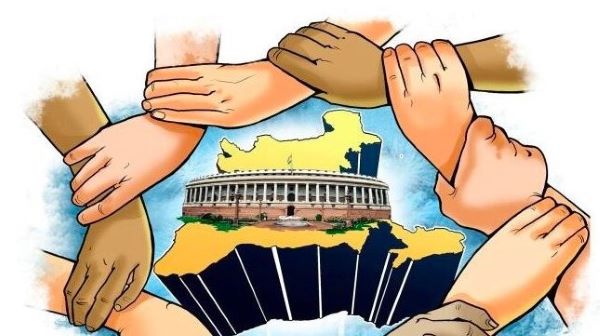Date : 18/11/2023
Relevance: GS Paper 2 - Polity- Federalism ( Also Relevance: GS Paper 3- Fiscal Federalism)
Keywords: Cooperative Federalism, PM Gati Sakti, fiscal federalism, center-state relations
Context-
The relationship between the Union government and the States in India has historically been marked by disputes, but recent years have witnessed a surge in both the frequency and intensity of these conflicts. Referred to as 'persistent frictions,' these disputes are not only affecting the cooperative federalism model but also leaving a lasting impact on the economic landscape.
Federalism in India:
- Vertical division of power in a political system, dividing authority between a central government and other constituents.
- In India, power is distributed among the Central government, state governments, and local governance institutions.
Types of Federalism:
- Cooperative Federalism: Involves horizontal cooperation between entities for unified socio-economic development.
- Competitive Federalism: Promotes healthy competition among states, motivating efforts for economic development.
- Fiscal Federalism: Deals with financial power division and functions between federal government levels. Involves taxes, their imposition, and fair division through constitutional authorities like India's Finance Commission.
Historical Context of Centre-State Disputes
Long History of Disputes
- Disputes between the Centre and States on economic policies have deep roots in India's political history.
- However, recent years have seen an escalation in the frequency and intensity of these conflicts, transforming them into persistent frictions within the federal system.
Cooperative Federalism Eroded
- The cooperative federalism model, essential for effective governance, is under threat due to the hardening stance of both the Centre and the States.
- Issues ranging from resource sharing to the homogenization of social sector policies have become contentious, challenging the collaborative spirit of cooperative federalism.
Changing Economic Landscape
Evolving Economic Relations
- The economic relations between the Centre and States have undergone significant changes since the 1980s and 1990s.
- While economic reforms since 1991 have granted some autonomy to States in terms of investments, their control over public expenditure policies remains constrained by their dependence on the Centre for revenue receipts.
Give and Take Equation Shifts
- The traditional 'give and take' equation between the Centre and States has transformed into a more rigid standoff, limiting room for negotiation.
- As economic reforms continue, the autonomy of States is further curtailed, leading to persistent frictions that erode the foundations of cooperative federalism.
Economic Consequences of Frictions
A. Centre Crowding Out States in Investments
- Infrastructure Development Dilemma
- Recent infrastructure development initiatives, such as PM Gati Shakti, aimed at achieving integrated planning, reveal a scenario where the Centre's dominance leads to crowding out of States in terms of investments.
- The centralization of planning and implementation restricts the flexibility of States in formulating their master plans, resulting in underinvestment by States in crucial areas.
- Disparities in Capital Expenditure
- Examining capital expenditure (capex) on roads and bridges, it becomes evident that the Centre's capex has grown significantly, while the States' growth has been comparatively modest.
- Disparities among States, with Uttar Pradesh, Maharashtra, and Gujarat dominating spending, further highlight the challenges posed by the Centre's increased influence.
B. Fiscal Competition and Welfare Provisioning
- Peculiar Fiscal Competition
- The persistent frictions have given rise to a unique form of fiscal competition between the Centre and States. Rather than competing regionally, State governments find themselves competing with both other States and the Centre.
- This competition, particularly in welfare provisioning, is exacerbated by the enhanced fiscal space of the Centre.
- Spending Power Disparities
- While the Centre enjoys increased spending power, States face limitations, especially in non-tax revenues, as the Centre directly provides many utilities and services.
- This disparity in spending power leads to an uneven playing field in welfare provisioning, affecting the overall economic well-being of citizens.
C. Inefficiencies of Parallel Policies
- Emergence of Parallel Policies
- Federal abrasions result in the emergence of parallel policies, with both the Centre and States duplicating each other's efforts.
- The case of pension reforms exemplifies this, with some States reverting to old pension schemes due to a trust deficit in the federal system.
- Long-Term Consequences on Economy
- The inefficiencies associated with parallel policies, such as pension reforms, have long-term consequences on the economy.
- Trust deficits prevailing in the federal system contribute to States rolling back on certain schemes, impacting the fiscal health of the nation.
Preserving Inevitable Interdependence
Need for Interdependence
- Despite the persistent frictions, the interdependence between the Centre and States remains crucial for effective governance.
- Many laws and policies implemented by the Centre require the cooperation of States, particularly in concurrent spheres, highlighting the necessity of preserving this interdependence.
Balanced Approach to Cooperative Federalism
- Striking a balance between the autonomy of States and the overarching goals of the Centre is essential for fostering a cooperative federalism that benefits both levels of government.
- Addressing trust deficits and promoting dialogue is pivotal in achieving a harmonious economic relationship.
Conclusion:
The economic implications of persistent frictions between the Centre and States in India are far-reaching, affecting infrastructure development, fiscal competition, and the efficiency of policies. While the evolving economic landscape provides some room for States, the challenges posed by the dominance of the Centre need careful consideration. Striking a balance between cooperative federalism and the autonomy of States is crucial for ensuring sustainable economic growth and effective governance in the diverse and dynamic Indian context. As India navigates its path towards development, resolving these persistent frictions becomes imperative for the overall well-being of the nation.
Probable Questions for UPSC mains Exam-
- Question 1: What historical factors have contributed to the escalation of persistent frictions between the Centre and States in India, particularly in the context of economic policies? (10 Marks,150 Words)
- Question 2: Discuss the economic consequences of the Centre's dominance in infrastructure development, highlighting the challenges faced by States in terms of investments and the resulting disparities in capital expenditure. (15 Marks,250 Words)
Source- The Hindu







